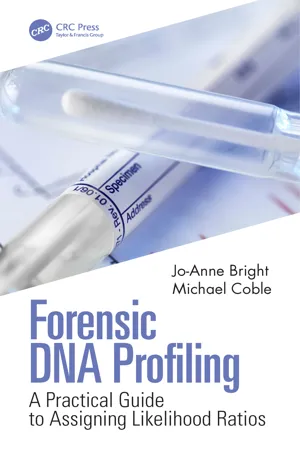
Forensic DNA Profiling
A Practical Guide to Assigning Likelihood Ratios
- 242 pages
- English
- ePUB (mobile friendly)
- Available on iOS & Android
About this book
DNA testing and its forensic analysis are recognized as the "gold standard" in forensic identification science methods. However, there is a great need for a hands-on step-by-step guide to teach the forensic DNA community how to interpret DNA mixtures, how to assign a likelihood ratio, and how to use the subsequent likelihood ratio when reporting interpretation conclusions.
Forensic DNA Profiling: A Practical Guide to Assigning Likelihood Ratios will provide a roadmap for labs all over the world and the next generation of analysts who need this foundational understanding. The techniques used in forensic DNA analysis are based upon the accepted principles of molecular biology. The interpretation of a good-quality DNA profile generated from a crime scene stain from a single-source donor provides an unambiguous result when using the most modern forensic DNA methods. Unfortunately, many crime scene profiles are not single source. They are described as mixed since they contain DNA from two or more individuals.
Interpretation of DNA mixtures represents one of the greatest challenges to the forensic DNA analyst. As such, the book introduces terms used to describe DNA profiles and profile interpretation. Chapters explain DNA extraction methods, the polymerase chain reaction (PCR), capillary electrophoresis (CE), likelihood ratios (LRs) and their interpretation, and population genetic models—including Mendelian inheritance and Hardy-Weinberg equilibrium. It is important that analysts understand how LRs are generated in a probabilistic framework, ideally with an appreciation of both semicontinuous and fully continuous probabilistic approaches.
KEY FEATURES:
• The first book to focus entirely on DNA mixtures and the complexities involved with interpreting the results
• Takes a hands-on approach offering theory with worked examples and exercises to be easily understood and implementable by laboratory personnel
• New methods, heretofore unpublished previously, provide a means to innovate deconvoluting a mixed DNA profile, assign an LR, and appropriately report the weight of evidence
• Includes a chapter on assigning LRs for close relatives (i.e., "It's not me, it was my brother"), and discusses strategies for the validation of probabilistic genotyping software
Forensic DNA Profiling fills the void for labs unfamiliar with LRs, and moving to probabilistic solutions, and for labs already familiar with LRs, but wishing to understand how they are calculated in more detail. The book will be a welcome read for lab professionals and technicians, students, and legal professionals seeking to understand and apply the techniques covered.
Frequently asked questions
- Essential is ideal for learners and professionals who enjoy exploring a wide range of subjects. Access the Essential Library with 800,000+ trusted titles and best-sellers across business, personal growth, and the humanities. Includes unlimited reading time and Standard Read Aloud voice.
- Complete: Perfect for advanced learners and researchers needing full, unrestricted access. Unlock 1.4M+ books across hundreds of subjects, including academic and specialized titles. The Complete Plan also includes advanced features like Premium Read Aloud and Research Assistant.
Please note we cannot support devices running on iOS 13 and Android 7 or earlier. Learn more about using the app.
Information
Table of contents
- Cover
- Half Title
- Title Page
- Copyright Page
- Contents
- Foreword
- Preface
- Acknowledgments
- Authors
- 1. An Introduction and Review of DNA Profile Interpretation
- 2. An Introduction to Statistics and Proposition Setting
- 3. Assigning the LR: Single-Source Examples and Population Genetic Models
- 4. Application of the Binary LR for Mixtures
- 5. LRs Considering Relatives as Alternate Contributors
- 6. Probabilistic Genotyping: Semicontinuous Models
- 7. Probabilistic Genotyping: Continuous Models
- 8. Considerations on Validation of Probabilistic Genotyping Software
- Appendix 1: Allele Frequencies
- Appendix 2: Model Answers
- References
- Index